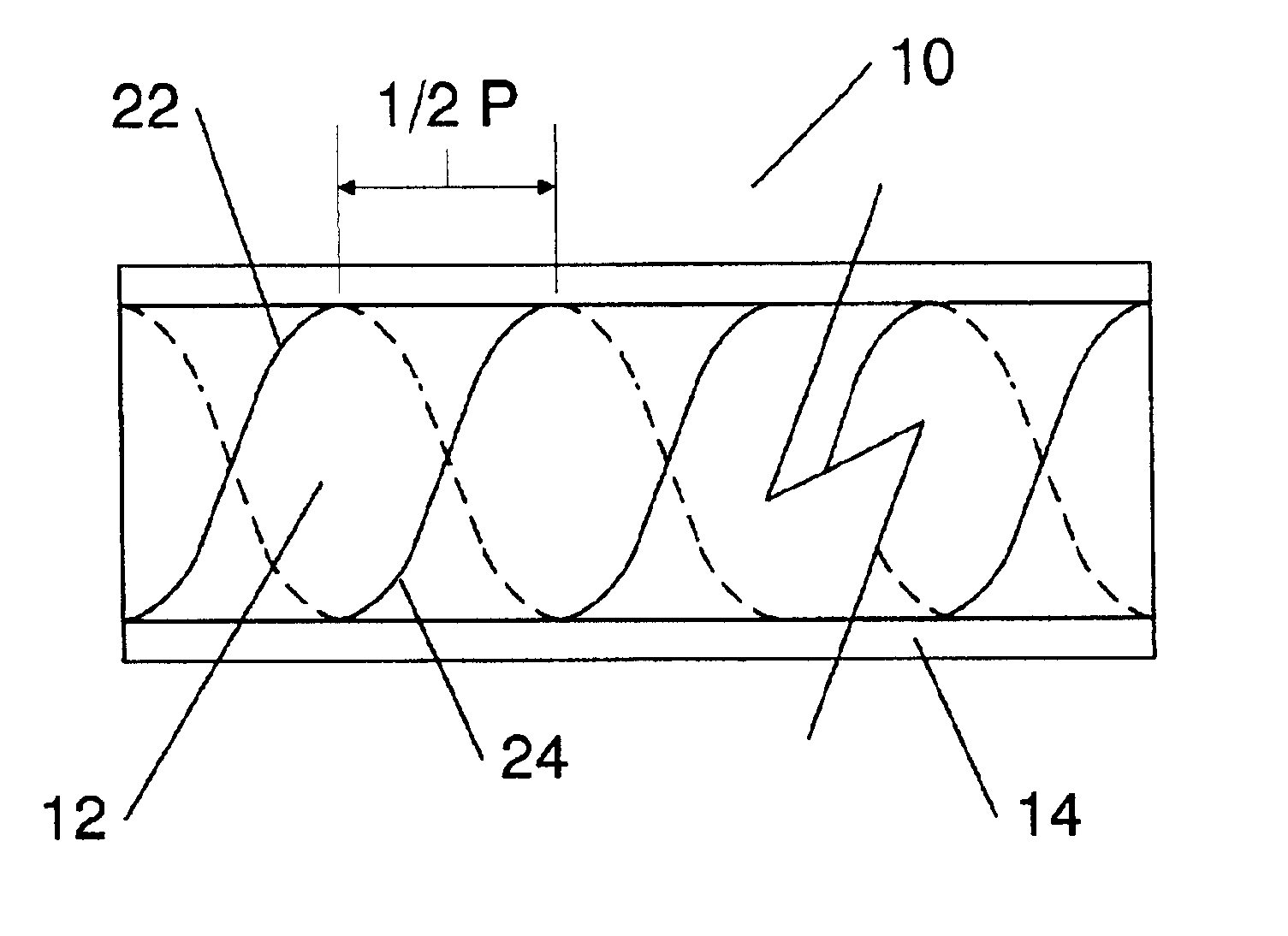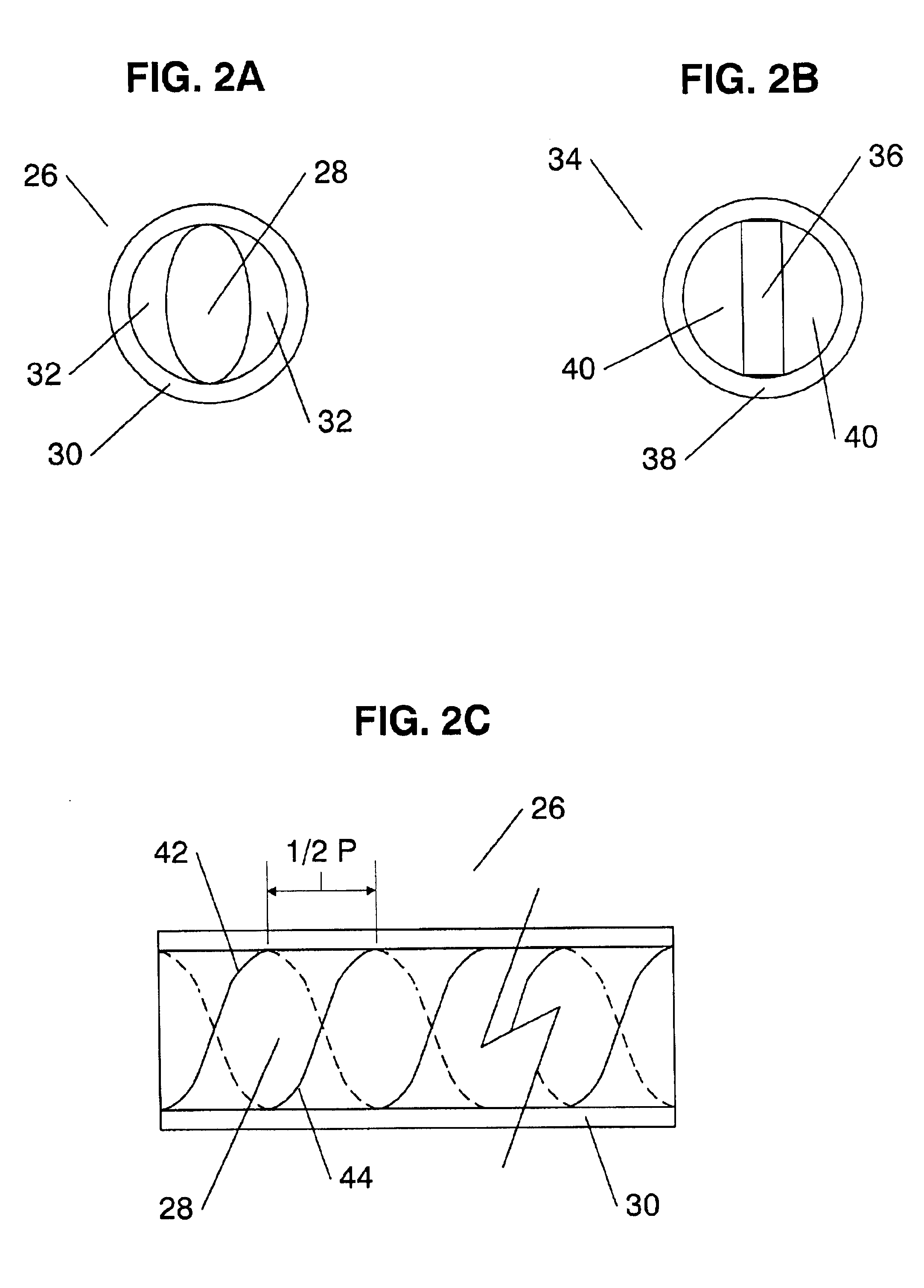Chiral fiber grating
- Summary
- Abstract
- Description
- Claims
- Application Information
AI Technical Summary
Benefits of technology
Problems solved by technology
Method used
Image
Examples
first embodiment
Referring now to FIGS. 1A to 1C, the present invention is shown where a chiral fiber 10 includes a core 12 with an oval cross-section and an optional cladding 14 surrounding the core 12. An alternate embodiment of the chiral fiber 10 is shown as a chiral fiber 16 with a rectangular core 18 and an optional cladding 20. It should be noted that the oval and rectangular cross sections of FIGS. 1A and 1B are shown by way of example only and other non-circular cross sectional shapes having 180 degree cross-sectional symmetry may be used as a matter of design choice without departing from the spirit of the invention.
FIG. 1C shows a cross section of the chiral fiber 10 twisted about its longitudinal axis. Because the core 12 has non-circular 180 degree cross-sectional symmetry, when the chiral fiber 10 is twisted about its longitudinal axis, a double helix structure is thereby formed, with a second helix 24 being displaced forward from a first helix 22 by one half of the pitch of the chiral...
second embodiment
Referring now to FIGS. 2A to 2C, the present invention is shown where a chiral fiber 26 includes a core 28 with an oval cross-section and an optional hollow cylindrical cladding 30 either surrounding or in contact with the core 28. A dielectric material 32 is disposed within the empty space between the core 28 and an inner surface of the cladding 20. The dielectric material 32 may be any dielectric substance with different optical characteristics from the core 28. For example, the material 32 may be air, dielectric fluid, or glass with different properties from the core 28. An alternate embodiment of the chiral fiber 26 is shown as chiral fiber 34 with a rectangular core 36, an optional hollow cylindrical cladding 38 and a dielectric material 40 disposed in the empty space between the core 36 and the inner surface of the cladding 38. It should be noted that the oval and rectangular cross sections of FIGS. 2A and 2B are shown by way of example only and other non-circular cross sectio...
third embodiment
Referring now to FIGS. 3A and 3B, the present invention is shown where chiral fiber 44 includes a core 46 that is composed of a first quarter-cylindrical portion 48 of a first material in contact on each side with a second and third quarter cylindrical portions, 52, 54 composed of a second material, and a fourth quarter-cylindrical portion 50 of the first material contacting its sides with the second and third quarter cylindrical portion 52, 54 sides that are not in contact with the first quarter-cylindrical portion 48; where all vertices of the first, second, third and fourth quarter-cylindrical portions 48, 50, 52, 54 are aligned with the central longitudinal axis of the chiral fiber 44. Each of the first and second materials have different optical properties. The first and second materials may be selected from a variety of glass and other dielectric substances as a matter of design choice. For example, one of the materials may be air. The core 46 is enclosed by an optional claddi...
PUM
 Login to View More
Login to View More Abstract
Description
Claims
Application Information
 Login to View More
Login to View More - R&D
- Intellectual Property
- Life Sciences
- Materials
- Tech Scout
- Unparalleled Data Quality
- Higher Quality Content
- 60% Fewer Hallucinations
Browse by: Latest US Patents, China's latest patents, Technical Efficacy Thesaurus, Application Domain, Technology Topic, Popular Technical Reports.
© 2025 PatSnap. All rights reserved.Legal|Privacy policy|Modern Slavery Act Transparency Statement|Sitemap|About US| Contact US: help@patsnap.com



